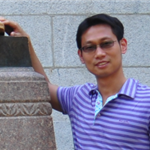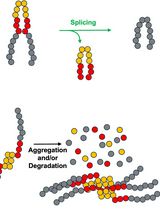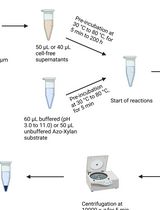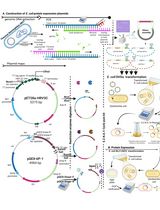- EN - English
- CN - 中文
Expression and Purification of Cyanobacterial Circadian Clock Protein KaiC and Determination of Its Auto-phosphatase Activity
蓝细菌生物钟蛋白KaiC的表达和纯化及其自磷酸化酶活性测定
发布: 2017年02月20日第7卷第4期 DOI: 10.21769/BioProtoc.2140 浏览次数: 8091
评审: Dennis NürnbergAnna A. ZorinaEsteban Paredes-Osses
Abstract
Circadian rhythms are biological processes displaying an endogenous oscillation with a period of ~24 h. They allow organisms to anticipate and get prepared for the environmental changes caused mainly by the rotation of Earth. Circadian rhythms are driven by circadian clocks that consist of proteins, DNA, and/or RNA. Circadian clocks of cyanobacteria are the simplest and one of the best studied models. They contain the three clock proteins KaiA, KaiB, and KaiC which can be used for in vitro reconstitution experiments and determination of the auto-phosphatase activity of KaiC as described in this protocol.
Keywords: KaiA (KaiA)Background
The rotation of planet Earth causes the ~24 h day-night oscillation. To fit in and then efficiently take advantage of this rhythmic change of the environment, most if not all organisms have an endogenous activity rhythm of ~24 h, which is called circadian rhythm. Circadian rhythms provide evolutionary advantages to those organisms. The long-term disruption of circadian rhythms is extremely harmful (Ma et al., 2013). In humans, many diseases, including cancer, hypertension, and sleep disorders, are closely related with a disrupted circadian rhythm (Shi et al., 2013; Roenneberg and Merrow, 2016).
Circadian rhythms are controlled by endogenous rhythm generators called circadian clocks. A functional circadian clock has three functionalities: accepting the environmental information, turning the environmental cues into oscillating signals, and relaying these signals to down-stream modulators (Pattanayak and Rust, 2014). Cyanobacteria are the simplest organisms having a well-studied circadian clock, in which the oscillation generator is controlled by three proteins: KaiA, KaiB, and KaiC (Mackey et al., 2011; Johnson et al., 2011; Chen et al., 2013; Egli and Johnson, 2013). KaiC is a multi-functional protein, which has auto-kinase, auto-phosphatase, and ATPase activity (Egli, 2015). The auto-kinase activity results in the phosphorylation of the two key residues T432 and S431 in KaiC, whereas the auto-phosphatase activity results in their de-phosphorylation (Rust, 2012). When incubated alone, KaiC shows mainly phosphatase activity (Nishiwaki and Kondo, 2012). KaiA can stimulate the auto-kinase activity of KaiC, and KaiB antagonizes KaiA’s function, which makes the phosphorylation state of KaiC oscillate in a ~24 h rhythm (Dong et al., 2016).
In 2005, Nakajima et al. successfully reconstituted the KaiABC oscillator in vitro by mixing the purified proteins, KaiA, KaiB, and KaiC, in a buffer containing ATP and Mg2+ (Nakajima et al., 2005). The simple procedure made the KaiABC system a highly attractive model for studying the molecular mechanism of circadian clocks. In this protocol, a major part of the reconstitution system, the in vitro determination of the auto-phosphatase activity of KaiC is described, in which the phosphorylation states of KaiC are analyzed by SDS-PAGE.
Materials and Reagents
- 1.5 ml microcentrifuge tubes
- 15 ml tube (Corning, Axygen®, catalog number: SCT-15mL-25-S )
- 50 ml centrifuge tube (Corning, Axygen®, catalog number: SCT-50mL-25-S )
- Petri dish (Corning, catalog number: 70165-60 )
- Hitrap FF Q column: 5 ml (GE Healthcare, catalog number: 17-5156-01 )
- NAP-5/25 buffer exchange column (GE Healthcare, catalog number: 17-0853-02 )
- Centrifugal filter: 10 kDa, Amicon Ultra (EMD Millipore, catalog number: PR02967 )
- 0.22 µm filter (Pall, catalog number: PN 4612 )
- PCR tube (Bio-Sharp, catalog number: BS-02-P )
- 0.45 µm filter
- E. coli strain BL21 (DE3) (New England Biolabs, catalog number: C2527 )
- pGEX-6P-1-KaiC: Provided by Prof. Carl Johnson (Vanderbilt University, USA). The KaiC-coding sequence is from Synechococcus elongatus PCC 7942
- Bacto-tryptone (Oxoid, catalog number: LP0042 )
- Bacto-yeast extract (Oxoid, catalog number: LP0021 )
- Agar A (Beijing Dingguo Changsheng Biotechnology, catalog number: DH010 )
- Calcium chloride (CaCl2) (1 M; Sigma-Aldrich, catalog number: V900266 )
- Ampicillin (1 mg/ml; North China Pharmaceutical Group Corporation, catalog number: A102048-25g )
- Isopropyl β-D-1-thiogalactopyranoside (IPTG) (Sigma-Aldrich, catalog number: 16758 )
- Glutathione S-transferase (GST) resin (EMD Millipore, catalog number: 70541 )
- PreScission protease (PSP) (GE Healthcare, catalog number: 27-0843-01 )
- Kanamycin (1 mg/ml; GENVIEW, catalog number: AK177-10G )
- 3x loading dye
- Tris-base (AMRESCO, catalog number: 0497 )
- Sodium chloride (NaCl) (Sigma-Aldrich, catalog number: 7647-14-5 )
- Dithiothreitol (DTT) (Life Science Products&Services, catalog number: DB0058-25g )
- Tween-20 (Enox, catalog number: 557 )
- ATP (Life Science Products&Services, catalog number: AB0020-25g )
- Magnesium chloride (MgCl2) (Sigma-Aldrich, catalog number: M8266 )
- EDTA (Bio Basic, catalog number: EB0185 )
- Glycerol (Sigma-Aldrich, catalog number: G5516 )
- SDS (Life Science Products&Services, catalog number: SB0485 )
- Bis-acrylamide (Sigma-Aldrich, catalog number: 146072 )
- Ammonium persulfate (APS) (Xilong Scientific, catalog number: 51504 )
- TEMED (CUSABIO, catalog number: V900853 )
- Pierce Coomassie (Bradford) Protein Assay Kit (Sangon Biotech, catalog number: C503031 )
- Bromophenol blue (Sigma-Aldrich, catalog number: 115-39-9 )
- Methanol (Tianjin Kermel Chemical Reagent, catalog number: 32058 )
- Acetic acid (Heng Xing, catalog number: 81601 )
- Acrylamide (AMRESCO, catalog number: 0341 )
- Protein marker (SM0431, Fermantas) (Thermo Fisher Scientific, Thermo ScientificTM, catalog number: 26610 )
- GSH (Reduced Glutathione) (Sangon Biotech, catalog number: A100399 )
- Ethanol (Heng Xing, catalog number: 32061 )
- PSP buffer (see Recipes)
- Buffer A (see Recipes)
- Buffer B (see Recipes)
- Reaction buffer (see Recipes)
- 1 M IPTG (see Recipes)
- 10x running buffer (see Recipes)
- 8% separation gel (see Recipes)
- 5% stacking gel (see Recipes)
- Coomassie blue staining solution (see Recipes)
- De-staining buffer (see Recipes)
Equipment
- Autoclave sterilizer (Shanghai Huaxian Medical Equipment, model: HVA-85 )
- Laminar flow hood (SU ZHOU AN TAI, model: SW-CJ-2F )
- Electric Thermostatic incubator (Shanghai Yuejin Medical Apparatus Factory, model: SHP-250 )
- Pipettes (Gilson, catalog numbers: 711111170000 and 711111050000 )
- Orbital shaker (Thermo Fisher Scientific, Thermo ScientificTM, model: SHKE4000-1CE )
- High-speed refrigerated centrifuge (Hitachi, model: CR21G )
- Refrigerated centrifuge (Sigma Laborzentrifugen, model: 5811XQ 14241g )
- Benchtop centrifuge (Eppendorf, model: 1024 and 5424 )
- Ultra-low temperature freezer (Haier, model: 906 )
- Microplate spectrophotometer (Thermo Fisher Scientific, model: 1500 )
- Analytical balance (Sartorius, model: CP225D )
- Ultrapure water system (Pall, model: CascadA ZX )
- Membrane filter system (EMD Millipore, USA)
- Ultrasonic cell processor (Scientz Biotechnology, model: SCIENTZ-IID )
- FPLC system (GE Healthcare, model: AKTA Purifier 100 )
- Precision pH meter (Mettler Toledo, model: EL-20 )
- Electrophoresis system (Bio-Rad Laboratories, model: Mini-Protean Tetra )
- Decolorization shaker (Haimen Kylin-Bell Lab Instruments, model: TS-8 )
- Gel imaging system (Kodak, model: Gel Logic 200 )
- PCR system (Biometra, model: T-Gradient Thermoblock )
Software
- ImageJ (version 1.8.0_77, NIH, USA)
- Excel (version 2012, Microsoft, USA)
Procedure
文章信息
版权信息
© 2017 The Authors; exclusive licensee Bio-protocol LLC.
如何引用
Chen, Q., Yu, L., Tan, X. and Liu, S. (2017). Expression and Purification of Cyanobacterial Circadian Clock Protein KaiC and Determination of Its Auto-phosphatase Activity. Bio-protocol 7(4): e2140. DOI: 10.21769/BioProtoc.2140.
分类
微生物学 > 微生物生物化学 > 蛋白质 > 活性
微生物学 > 微生物生物化学 > 蛋白质 > 分离和纯化
生物化学 > 蛋白质 > 分离和纯化
您对这篇实验方法有问题吗?
在此处发布您的问题,我们将邀请本文作者来回答。同时,我们会将您的问题发布到Bio-protocol Exchange,以便寻求社区成员的帮助。
Share
Bluesky
X
Copy link

















